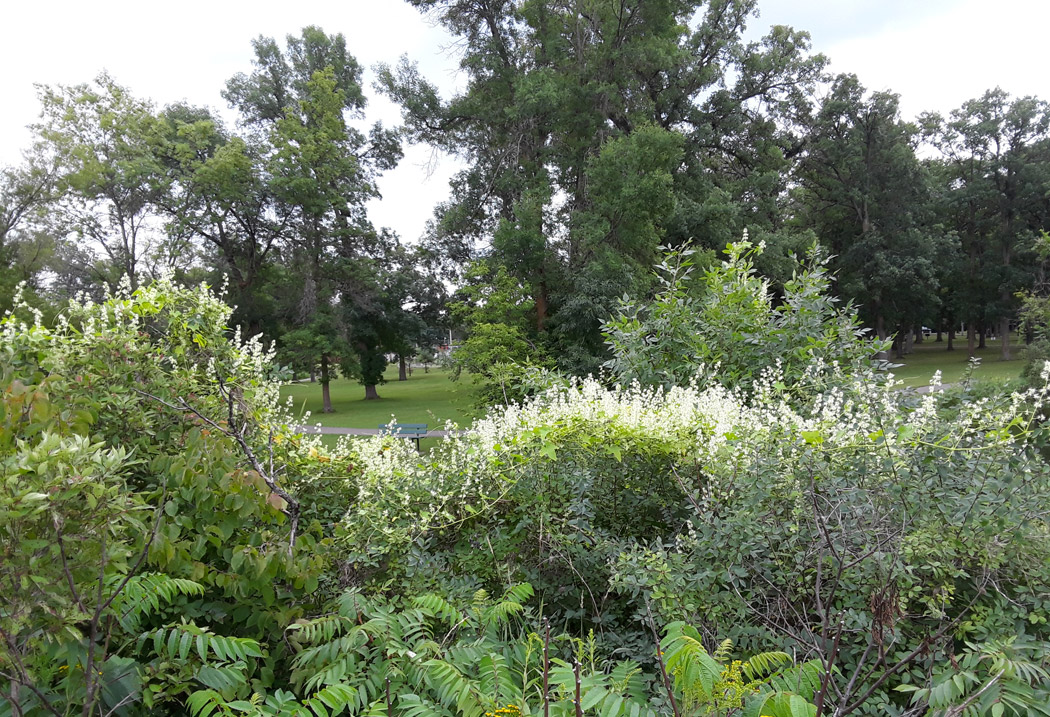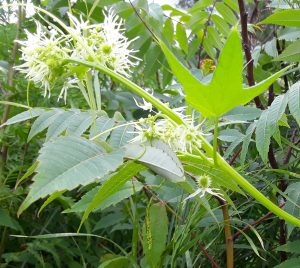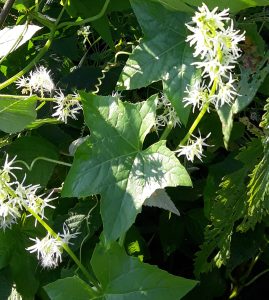Wild Cucumber
 Echinocystis lobata is in the Cucumber family, but in a different genus altogether from the edible cucumbers that grow in gardens. Wild cucumber grows native to N. America and flowers in mid to late summer, July through September, appearing rather inconspicuous before it blooms. Indeed, after daily walks along the same path you’ve traversed all summer, one day in August you may be rather shocked to see the landscape quite changed, with wild cucumber flowers sprawling without restraint atop the shrubbery along the trail. Male and female flowers are on the same vine on this monecious, vining plant typical of cucumber foliage. Male flowers grow straight upwards on 4″ – 6″ stalks and certainly draw attention to themselves. Female flowers sit at the base of the males, with similar flowers save for the short stalk and spiny ovary that sits beneath the petals. Wild cucumber in full bloom is a very showy sight, yet for all that clustered loveliness the species does little to no harm to the plants on which it sends its tendrils out for handholds as it entwines itself skyward. Once the vine reaches the terminus of its host vegetation, the branching tendrils of the vine continue to grab on horizontally to continue the vine on its merry way for up to 25 feet. The leaves of wild cucumber resemble a hand, with 5 distinct, triangular-shaped lobes.
Echinocystis lobata is in the Cucumber family, but in a different genus altogether from the edible cucumbers that grow in gardens. Wild cucumber grows native to N. America and flowers in mid to late summer, July through September, appearing rather inconspicuous before it blooms. Indeed, after daily walks along the same path you’ve traversed all summer, one day in August you may be rather shocked to see the landscape quite changed, with wild cucumber flowers sprawling without restraint atop the shrubbery along the trail. Male and female flowers are on the same vine on this monecious, vining plant typical of cucumber foliage. Male flowers grow straight upwards on 4″ – 6″ stalks and certainly draw attention to themselves. Female flowers sit at the base of the males, with similar flowers save for the short stalk and spiny ovary that sits beneath the petals. Wild cucumber in full bloom is a very showy sight, yet for all that clustered loveliness the species does little to no harm to the plants on which it sends its tendrils out for handholds as it entwines itself skyward. Once the vine reaches the terminus of its host vegetation, the branching tendrils of the vine continue to grab on horizontally to continue the vine on its merry way for up to 25 feet. The leaves of wild cucumber resemble a hand, with 5 distinct, triangular-shaped lobes.
 I found these vines growing alongside the river trail over several kinds of bushes including sumac, honeysuckle, and a large cluster of jewelweed. Wild cucumber loves this sort of moisture laden area along riverbanks and streams, swamps and moist, roadside thickets. When ripe, the fruit pod becomes dry and brown. Inside are two cavities, with 2 seeds in each. When the fruit pod is ready it expels the seeds in a little hydrostatic explosion out the bottom that might be worth the wait to see! Unfortunately, the fruit itself is not edible, but I read that the tender leaves and tips are. I tried some this evening and they were delicious stir fried with olive oil and seasonings. The flowers emanate a sweet, attractive scent — an opinion with which the pollinators who visit in droves would agree.
I found these vines growing alongside the river trail over several kinds of bushes including sumac, honeysuckle, and a large cluster of jewelweed. Wild cucumber loves this sort of moisture laden area along riverbanks and streams, swamps and moist, roadside thickets. When ripe, the fruit pod becomes dry and brown. Inside are two cavities, with 2 seeds in each. When the fruit pod is ready it expels the seeds in a little hydrostatic explosion out the bottom that might be worth the wait to see! Unfortunately, the fruit itself is not edible, but I read that the tender leaves and tips are. I tried some this evening and they were delicious stir fried with olive oil and seasonings. The flowers emanate a sweet, attractive scent — an opinion with which the pollinators who visit in droves would agree.
 While it has been used in traditional herbal medicine, I intend to approach wild cucumber come fall harvest time from the artist’s perspective (holding their spiny bodies carefully) with the intention of creating dried flower arrangements and decorative still life art pieces.
While it has been used in traditional herbal medicine, I intend to approach wild cucumber come fall harvest time from the artist’s perspective (holding their spiny bodies carefully) with the intention of creating dried flower arrangements and decorative still life art pieces.
